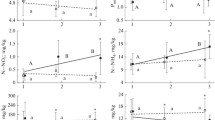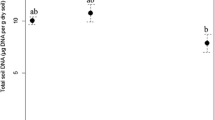Abstract
Effects of soil management on soil characteristics were investigated on the rhizosphere (RPP) and the nonrhizosphere (NRPP) soil of a re-grass vertisol underDigitaria decumbens and in the soil under continuous cultivation (CC). A low energy technique allowed to separate eight size and density fractions, including macro- and micro-aggregates while preserving soil bacteria. Organic C and N, microbial biomass C and the number of total bacteria (AODC) and ofAzospirillum brasilense and their distribution were determined in soil fractions isolated from the CC, NRPP and RPP soils. Soil macroaggregates (>2000 μm) were similarly predominant in the NRPP and RPP soils when the dispersible clay size fraction (<2 μm) respresented more than 25% of the CC soil mass. The main increase of C content in RPP originated from the macroaggregates (> 2000 μm) and from the root fraction, not from the finer separates. The proportion of organic C as microbial biomass C revealed the low turnover of microbial C in the PP situations, especially in the clay size fraction of the NRPP soil. A common shift of AODC toward the finer separates from planted soils (CC and RPP) revealed the influence of living plants on the distribution of soil bacteria. The relative abundance ofA. brasilense showed the presence of the active roots ofDigitaria in the macroaggregates and their contact with the dispersible clay size fraction of the rhizosphere soil.
Similar content being viewed by others
References
Amato M and Ladd J N 1988 Assay for biomass based on ninhydrine reactive nitrogen in extracts of fumigated soils. Soil Biol. Biochem. 20, 107–114.
Amato M and Ladd J N 1992 Decomposition of14C-labelled glucose and legume material in soils: properties influencing the accumulation of organic residue C and microbial biomass C. Soil Biol. Biochem. 24, 455–464.
Angers D A, N'dayegamiye A and Côté D 1993 Tillage-induced differences in organic matter of particle-size fractions and microbial biomass. Soil Sci. Soc. Am. J. 57, 512–516.
Balandreau J and Knowles R 1978 The rhizosphere.In Interactions between non-pathogenic soil microorganisms and plants. Eds. Y R Dommergues and S V Krupa. pp 243–266. Elsevier Scientific Publishing Company, New-York.
Cambardella C A and Elliott E T 1992 Particulate soil organic-matter changes across a grassland cultivation sequence. Soil Sci. Soc. Am. J. 56, 777–783.
Catroux G and Schnitzer M 1987 Chemical, spectroscopic, and biological characteristics of the organic matter in particle size fractions separated from an Aquoll. Soil Sci. Soc. Am. J. 51, 1200–1207.
Chaussod R, Nicolardot B, Catroux G and Chretien J 1986 Relationships between physico-chemical and biological characteristics of a few cultivated soils. Science du Sol 24, 213–221.
Chotte J L, Jocteur Monrozier L, Villemin G and Albrecht A 1992 Soil microhabitats and the importance of the fractionation method.In Soil Organic Matter Dynamics and Sustainability of Tropical Agriculture. Eds. K Mulongoy and R Merckx. pp 39–45. Wiley-Sayce Publishers, IITA/KU Leuven, The Netherlands.
Chotte J L, Villemin G, Guilloré P and Jocteur Monrozier L 1993 Morphological aspects of microorganism habitats in a vertisol.In International Workshop on Soil Micromorphology (Townsville, Australia, 12–17 July 1992). Elsevier, Amsterdam, The Netherlands.
Christensen B T 1992 Physical fractionation of soil and organic matter in particle size and density separates. Adv. Soil Sci. 20, 1–90.
Collins H P, Rasmussen P E and DouglasJr C L 1992 Crop rotation and residue management effects on soil carbon and microbial dynamics. Soil Sci. Soc. Am. J. 56, 783–788.
Dorioz J M and Robert M 1987 Aspects microscopiques des relations entre les microorganismes ou les végétaux et les argiles. Conséquences sur les microorganisations et sur la microstruturation des sols.In Soil Micromorphology. Eds. N Fedoroff, L Bresson and M A Courty. pp 353–361. AFES, Paris, France.
Day J M and Döbereiner J 1976 Physiological aspects of N2 fixation by aSpirillum ofDigitaria roots. Soil Biol. Biochem. 8, 45–50.
Döbereiner J and Pedrosa F O 1987 Nitrogen fixing bacteria in nonleguminous crop plants. Soil Sci. Soc. Am. Proc. 43, 951–955.
Duchaufour P 1977 Dynamique de la matière organique.In Pédologie 1: Pédogénèse et classification. Eds. P Duchaufour et B Souchier. pp 28–70. Masson, Paris, France.
Elliott E T 1986 Aggregate structure and carbon, nitrogen, and phosphorus in native and cultivated soils. Soil Sci. Soc. Am. Proc. 50, 627–633.
Foster R C 1988 Microenvironments of soil microorganisms. Biol. Fertil. Soils 6, 189–203.
Foster R C, Rovira A D and Cock T W 1983 Ultrastructure of the root-soil interface. The American Phytopathological Society, St Paul, Minnesota, USA. 156p.
Gamard P 1991 Etude de populations d'Azospirillum dans la rhizosphère; Caractérisation sérologique et activité dénitrifiante. Thèse Univ. Lyon 1, France. 173p.
Gray T R G and Williams S T 1971 Microbial productivity in soils. Gen. Microbiology Soc. Symposium. pp 255–286.
Hart P B S, August J A, Ross C W and Jullian J F 1988 Some biochemical and physical properties of Tokomaro silt loam under pasture and after 10 years of cereal cropping. New-Zeal. J. Agric. Res. 31, 77–86.
Hassink J, Bouwman L A, Zwart K B and Brussaard L 1993 Relationships between habitable pore space, soil biota and mineralization in grassland soils. Soil Biol. Biochem. 25, 47–55.
Hattori T 1988 Soil aggregates as microhabitats of microorganisms. Rep. Inst. Agr. Res. Tohoku Univ. 37, 23–36.
Haynes R J and Swift R S 1990 Stability of soil aggregates in relation to organic constituents and soil water content. J. Soil Sci. 41, 73–83.
Jocteur Monrozier L, Ladd J N, Fitzpatrick R W, Foster R C and Raupach M 1991 Components and microbial biomass content of size fractions in soils of contrasting aggregation. Geoderma 49, 37–62.
Ladd J N and Amato M 1988 Relationships between biomass14C of a range of fumigate soils. Soil Biol. Biochem 20, 115–116.
Ladd J N and Foster R M 1987 Role of soil microflora in nitrogen turn-over.In Advances in Nitrogen Cycling in Agricultural Ecosystems. Ed. J R Wilson. pp 113–133. CAB International, Wallingford, Oxon, UK.
Mahboubi A A, Lal R and Faussey N R 1993 Twenty-eight years of tillage effects on two soils in Ohio. Soil Sci. Soc. Am. J. 57, 506–512.
Oades J M 1988 The retention of organic matter in soils. Biogeochemistry 5, 35–70.
O'Hara G W, Davey M R and Lucas J A 1983 Association between the nitrogen fixing bacteriumA. brasilense and excised plant roots. Z. Pflanze. Physiol. Bd. 113, 1–13.
Patriquin D G, Döbereiner J and Jain D K 1983 Sites and processes of association between diazotrophs and grasses. Can. J. Microbiol. 29, 900–915.
Postma J, Hok-a-hin C H and VanVeen J A 1990 Role of microniches in protecting introducedRhizobium leguminosarum biovartrifolii against competition and predation in soil. Appl. Environ. Microbiol. 56, 495–502.
Ramsay A J and Bawden A D 1983 Effects of sterilisation and storage on respiration, nitrogen status and direct counts of soil bacteria using acridine orange. Soil Biol. Biochem. 15, 263–268.
Reinhold B, Hurck T, Niemann E G and Fendrik I 1986 Close association ofAzospirillum and diazotrophic rods with different root zones of kallar grass. Appl. Environ. Microbiol. 52, 520–526.
Rutherford P M and Juma N G 1992 Influence of texture on habitable pore space and bacterial-protozoan populations in soil. Biol. Fertil. Soils 12, 221–227.
Russel E W 1973 Soil Conditions and Plant Growth. Longman, London, 849 p.
Santruckova H and Straskraba M 1991 On the relationship between specific respiration activity and microbial biomass in soils. Soil Biol. Biochem. 23, 525–532.
Schank C, Bouton J H, Weiser G C, Zuberer D A, Tyler M E, Milam J R and Littell R C 1979 Fluorescent antibody technique to identifyA. brasilense associated with roots of grasses. Soil Biol. Biochem. 11, 287–295.
Scherba G, Weige R M and O'BrienJr W D 1991 Quantitative assessment of the germicidal efficacy of ultrasonic energy. Appl. Environ. Microbiol. 57, 2079–2084.
Schmidt E 1974 Quantitative autoecological study of microorganisms in soil by immunofluorescence. Soil Science 118, 141–149.
Smith M S and Tiedje J M 1979 The effect of roots on soil denitrification. Soil Sci. Soc. Am. Proc. 43, 951–955.
Sparling G P, Ord B G and Vaughan D 1981 Changes in microbial biomass and activity in soils amended with phenolic acids. Soil Biol. Biochem. 13, 455–460.
Sparling G P and Cheshire M V 1985 Effect of periodate oxidation on the polysaccharide content and microaggregate stability of rhizosphere and non-rhizosphere soils. Plant and Soil 88, 113–122.
Stotzky G and Burns R G 1982 The soil environment: clay-humus microbe interaction.In Experimental Microbial Ecology. Eds. R G Burns and J H Slater. pp 105–133. Blackwell Scientific, Oxford, UK.
Tiessen H and Stewart J W B 1983 Particle size fractions and their studies of soil organic matter. II. Cultivation effects on organic matter composition in size fractions. Soil Sci. Soc. Am. J. 47, 509–514.
Tiessen H, Karamanos R E, Stewart J W B and Selles F 1984 Natural15N abundance as an indicator of soil organic transformations in native and cultivated soils. Soil Sci. Soc. Am. J. 48, 312–315.
Tisdall J M and Oades J M 1982 Organic matter and water stable aggregates in soil. J. Soil Sci. 32, 141–163.
Turchenek L W and Oades J M 1979 Fractionation of organo-mineral complexes by sedimentation and density techniques. Geoderma 21, 311–343.
Author information
Authors and Affiliations
Rights and permissions
About this article
Cite this article
Kabir, M., Chotte, J.L., Rahman, M. et al. Distribution of soil fractions and location of soil bacteria in a vertisol under cultivation and perennial grass. Plant Soil 163, 243–255 (1994). https://doi.org/10.1007/BF00007974
Received:
Accepted:
Issue Date:
DOI: https://doi.org/10.1007/BF00007974




